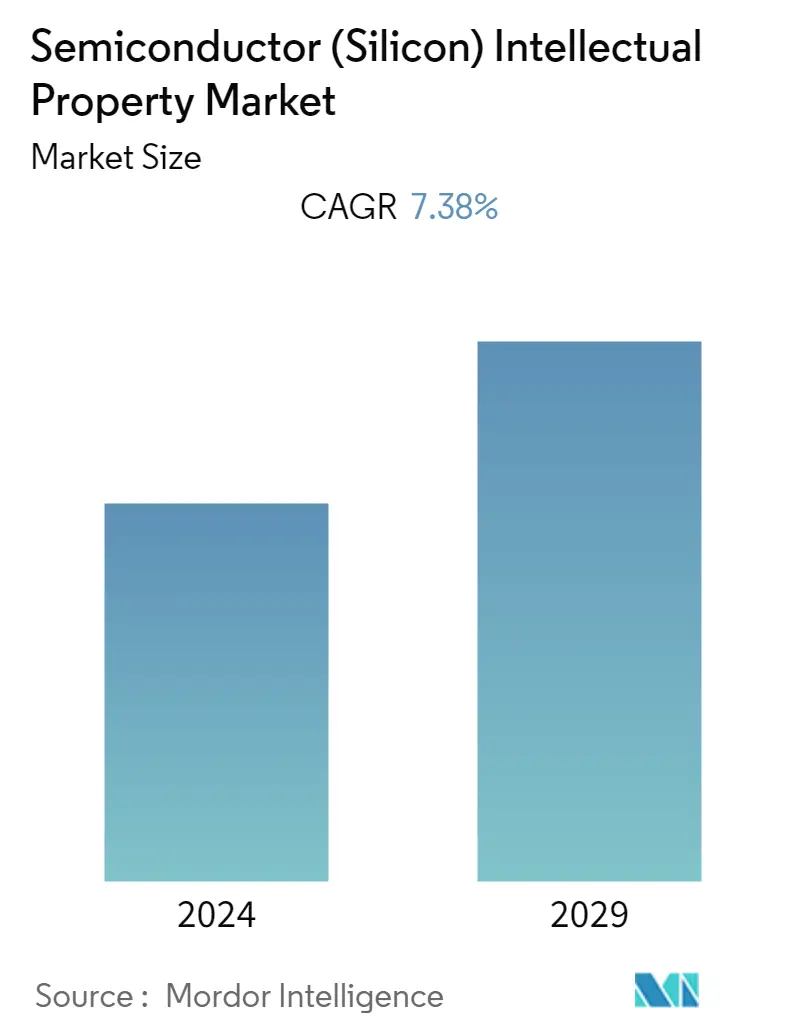Market Size of Semiconductor (Silicon) Intellectual Property Industry

| Study Period | 2019 - 2029 |
| Base Year For Estimation | 2023 |
| CAGR | 7.38 % |
| Fastest Growing Market | Asia Pacific |
| Largest Market | North America |
| Market Concentration | Low |
Major Players*Disclaimer: Major Players sorted in no particular order |
Need a report that reflects how COVID-19 has impacted this market and its growth?
Semiconductor Silicon Intellectual Property (IP) Market Analysis
The semiconductor (silicon) intellectual property market was valued at USD 6.26 billion in the previous year and is expected to register a CAGR of 7.38% during the forecast period to become USD 9.6 billion by the next five years.
- The semiconductor IP (SIP) market is witnessing rapid growth, with growing semiconductor sales. The market studied is entirely dependent on the semiconductor industry. The semiconductor business has experienced significant growth in the last two decades. The SIP business practices include elements similar to those in traditional semiconductor or application-specific integrated circuits (ASIC), electronic design automation (EDA), and design services markets. However, unlike the well-established business models in the ASIC and EDA industries, SIP business models tend to be more complex, as several parties in the supply chain are involved with successfully deploying commercial SIP in an IC design.
- Although business practices and SIP business models have become somewhat uniform, the industry still needs to achieve standardization due to the wide variety of SIP product types, customer needs, and frequent changes in EDA tools and process technologies. Rising design costs and increasing market pressures are forcing companies to seek the services of semiconductor IP manufacturers. The various applications of this market include automobiles, smart devices (mobiles and tablets), computers, and peripherals. The significant growth driver of the market studied includes the emerging global adoption of consumer devices and the demand for advanced SOC designs and connected devices. Emerging technologies such as embedded and programmable DSP-IP are expected to further boost the market.
- According to SEMI's latest quarterly World Fab Forecast report, the worldwide semiconductor industry will invest more than USD 500 billion between 2021 and 2023 in building 84 large-scale chip manufacturing facilities, including automotive and high-performance computing ( HPC), fueling the spending increases. The source also states that the global semiconductor materials market generated revenues of USD 72.69 billion in 2022, of which USD 20.13 billion was made in Taiwan. A further USD 12.97 billion was generated in China, a 7 percent increase from 2021.
- The complexity of system-on-chip (SoC) designs is outpacing systems engineering capabilities. Increasing design complexity has given rise to growing data size and, thus, making semiconductor development more challenging than before. This is expected to restrain the growth of the market.
- The COVID-19 pandemic impacted the entire semiconductor manufacturing market on both the demand and supply sides. Additionally, global lockdowns and semiconductor factory closures have exacerbated supply shortages. The impact was also reflected in the studied market. However, many of these effects may be short-term in nature. Measures by governments around the world to support the automotive and semiconductor sectors could stimulate industry growth.
